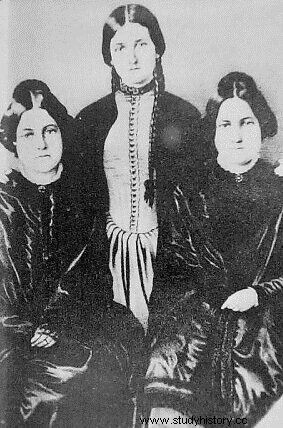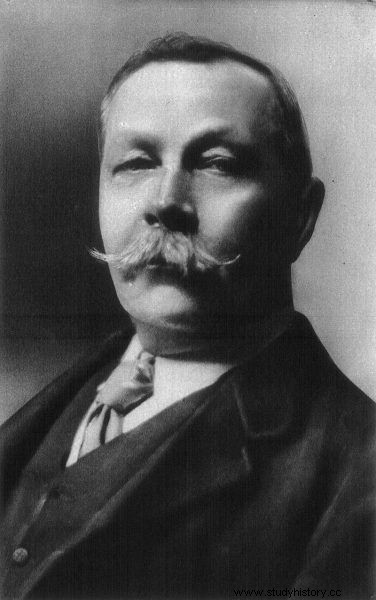Sir Arthur Conan Doyle was one of the most logical minds of the 20th century. He created the character of Sherlock Holmes and conducted criminal investigations himself. How is it possible that he became a zealous spiritualist?
There are two questions my friends keep asking me. First:How did I start writing Sherlock Holmes? And another why I became a spiritualist and about spiritualism in general.
With these words Sir Arthur Conan Doyle began his radio broadcast on May 14, 1930. And although it is very tempting to explore both of the above questions, it is impossible to answer them at the same time. If we follow the inspiration behind the creation of Sherlock Holmes, we will find one of the greatest and most logical minds of his era. If, on the other hand, we explore the spiritualist life of Conan Doyle, we can discover a whole new face of this famous writer.
It is worth remembering that Sir Conan Doyle, apart from writing about the brilliant detective, also solved criminal cases himself. One of them was described by Margalit Fox in her book, Arthur Conan Doyle and the Murder Case. The Real Investigation of the Creator of Sherlock Holmes. We have already written about this book on the Historical Curiosities. In the course of this incredibly addictive reading, I came across a very interesting mention that Conan Doyle was a spiritualist ! Could it be that one of the most logical minds of the age believed in ghosts? Let's see how it all happened and what Doyle himself had to say about it.

The article was inspired by the book "Arthur Conan Doyle and the Murder Case"
Spiritualism and its origins
The origins of spiritualism can be found in New York in 1848. Then the two sisters Fox Margaretta, 11, and Kate, 8, openly admitted hearing strange knocking sounds in their home. They figured it was the ghosts trying to communicate with them using Morse code. You might think that young girls would be ridiculed by society - but that didn't happen. On the contrary, two years later, spiritualism became even fashionable.
Spiritualism quickly became a religious movement which was based on the basic premise of the existence of an afterlife and the belief that humans can communicate with the world of the dead through a medium. Not only was it recognized that spiritualism was already rooted in shamanism and thus was considered "the oldest religion in the world"; this movement brought together the spiritual life with the world of science for the first time in the history of religion.

The Fox sisters started the spiritual movement
from left to right:Margaret, Kate and Leah Fox
Development and fighting for ideas
The spiritualist movement was rapidly gaining ground for a number of reasons. One of them was its extremely democratic character. In a world where people did not have equal rights and slavery was still possible, spiritualism accepted everyone. Anyone with a gift could become a medium. No wonder then that it attracted many people, especially women who were denied any leadership role in the Catholic Church.
The foundations for the new religious doctrine of the afterlife were laid by the Swedish mystic Emanuel Swedenborg and the German doctor Franz Anton Mesmer, who developed the hypnotic trance method. From the United States, the movement has spread to Great Britain, France, Australia, New Zealand, and Latin America.
As early as 1860, spiritualism began to lose its popularity. The main reason for this was the emergence of more and more fake media. But not only that. After all, the 1860s are the Civil War in the United States of America. At that time, people's minds and actions were focused elsewhere.
The spiritualist movement began to regain its glory in the 1920s. This is where our hero, Sir Arthur Conan Doyle, enters the arena.

Arthur Conan Doyle
Conan Doyle and the Spiritual Glory days
The creator of Sherlock received a medical education which, as he himself noted, made him a religious agnostic . So how did the person who believed there was no possibility of surviving death become a staunch supporter of the afterlife?
It is the hallmark of great minds that they are always open to new ideas, facts and research. It was no different with Conan Doyle. In 1887 he came across psychological experiments, and at that time he was particularly impressed by telepathy.
Fascinated by this idea, Sir Doyle conducted a series of telepathic experiments with his friend, and as a result, he asked himself a research question, which he would then study for over 20 years. If great minds can communicate with each other without using words, will these minds be capable of such communication if one of them is already detached from the body?
After years of research and experimentation, and by comparing the results with other researchers on the topic, Conan Doyle concluded that such communication is possible beyond all doubt .
Conan Doyle's research and spiritual activities fell on a very difficult period in history. The war times are a moment in people's lives where the question is often asked what happened to our loved ones?
Where are our boys? - with this question, Doyle summed up the mood of the era in which he acted. As he further stated in his radio statement on May 14, 1930, in such a difficult period neither the church nor science gave an answer to this then almost the most important question. The creator of Sherlock and his wife thought they knew the answer, and for 12 years they tried to convince people of their views.
There is nothing in this new knowledge that can destroy the foundations of your present faith, on the contrary - it adds knowledge and a feeling of certainty that no other philosophical system has been able to provide. The basis of all religions is the fact that there is life after death, and proving this as the truth is most necessary in my opinion. - convinces Doyle.

Many believed that the spiritualist movement could destroy religious foundations - Conan Doyle argued that these views were not valid
Sir Arthur Conan Doyle did more than just study and convince others of his views. In 1926 his two-volume work entitled The History of Spiritualism. In total, on 684 pages, the knowledge about this religious movement is presented here. We will find here, among others the story of the Fox sisters and many other important figures related to spiritualism, as well as issues such as the religious aspect of spiritualism and how spiritualists view the afterlife.
As we can see, spiritualism became an important religious movement that hit the appropriate era. The promise of the possibility of contacting loved ones, who had already died allowed for answering many questions that haunted people. What did spiritualism do? Let us give the floor to Sir Arthur Conan Doyle:
People ask:what do you get from spiritualism? The first thing you get is that you completely remove the fear of death. Second, spiritualism bridges the gap to our loved ones that we may lose.

The article was inspired by the book "Arthur Conan Doyle and the Murder Case"
